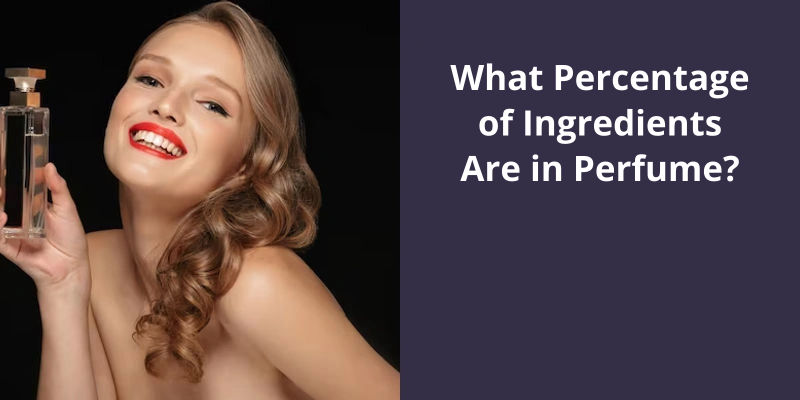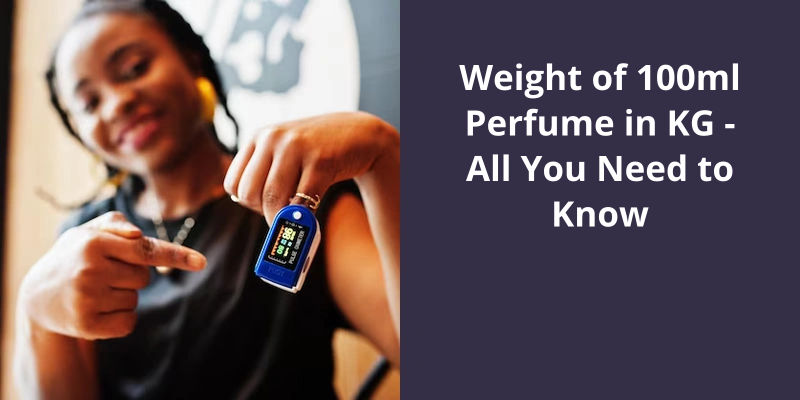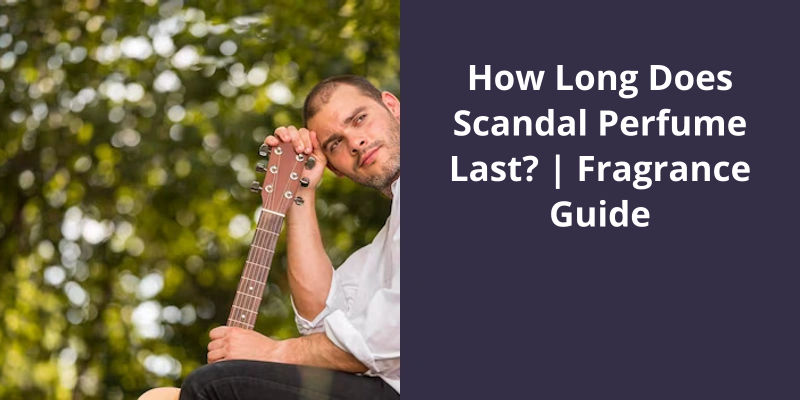The percentage of ingredients in a perfume can vary widely, but typically, it consists of about 20% to 30% pure perfume essence. The rest, approximately 70% to 80%, is composed mainly of alcohol and water, which are used to dilute the essence. Therefore, a large portion of a standard perfume is composed of solvents, with a smaller, but significant percentage dedicated to the actual scent compounds. However, this can change based on the type of perfume, as some may even contain up to 40% or more perfume essence.

What Is the Percentage Composition of Perfume?
Perfume, also known as perfume extract, is a highly concentrated fragrance solution that contains a varying percentage composition of different ingredients. The key component in perfume is the essence, which gives it it’s unique scent. The percentage of essence in perfume can range from 20 to 40%, depending on the specific brand and type of fragrance.
In addition to the essence, alcohol is another major ingredient in perfume. It accounts for a significant portion of the total mixture, typically ranging from 60 to 80%. It helps to dissolve and stabilize the essence, allowing for an even distribution of the fragrance. It also acts as a preservative, prolonging the shelf life of the perfume.
These can include water, solvents, and various additives such as fixatives, colorants, and emulsifiers.
Some perfumes may have a higher concentration of essence, resulting in a stronger and longer-lasting scent. Others may have a lower concentration, making the fragrance lighter and more subtle.
The remaining ingredients, such as water and additives, make up the remaining percentage. This combination of components creates a balanced and harmonious fragrance that can be enjoyed by individuals seeking a personal and unique scent experience.
To create a well-balanced perfume, the ratio of essential oil to carrier oil or alcohol is crucial. Perfume blends typically consist of roughly 15% to 30% essential oil, with the remaining portion made up of carrier oil or alcohol. This means that for every approximately 20 drops of essential oil or absolute, about 80 drops of carrier oil or alcohol are combined. Finding the perfect ratio is essential for achieving the desired scent and longevity of the fragrance.
What Is the Ratio of Making Perfume?
When it comes to creating the perfect perfume, understanding the ratio of ingredients is essential. Perfume blends typically consist of a combination of essential oils and carrier oils or alcohol.
A common guideline is to combine approximately 20 drops of essential oil with 80 drops of carrier oil or alcohol. This ratio falls within the 15% to 30% range mentioned earlier. This means that the essential oil represents around one-fifth of the total blend, while the carrier oil or alcohol makes up the remaining four-fifths.
The choice between a carrier oil or alcohol will depend on personal preference and the desired outcome. Carrier oils such as jojoba or almond oil are known for their moisturizing properties and can help prolong the scent on the skin. On the other hand, alcohol is often selected for it’s ability to evaporate quickly, resulting in a stronger initial fragrance.
It’s important to note that these percentages are guidelines and can be adjusted based on individual preferences and the specific scent being created.
This ratio can vary based on personal preference and the specific scent being created.
Source: Essential Oil Blending for Botanical Perfumes
The percentages of perfume vary based on the concentration of perfume oils in each type. Eau de Parfum typically contains 15-20% perfume oils, while Eau de Toilette has 5-15%. Eau de Cologne has a lower concentration of 2-5%, and Eau Fraîche has the lowest concentration at 1-3%.
What Are the Percentages of Perfume?
Perfumes come in various concentrations, which determine the percentage of perfume oils present in the formulation. Each concentration level offers a different intensity and longevity of fragrance. One of the most popular and potent concentrations is Eau de Parfum, which typically contains 15-20% perfume oils. This high concentration ensures a long-lasting scent that can linger on the skin for hours.
If you prefer a lighter fragrance that’s suitable for everyday wear, Eau de Toilette might be the perfect choice. It’s ideal for those who prefer a less overwhelming scent and want something more refreshing and invigorating.
For those seeking an even lighter option, there’s Eau de Cologne. With a concentration of perfume oils ranging from 2-5%, Eau de Cologne provides a subtle and fleeting fragrance that’s often used as a body splash or aftershave.
If you’re looking for a refreshingly mild fragrance with a minimal concentration of perfume oils, Eau Fraîche is the way to go. It typically contains 1-3% perfume oils, making it the lightest concentration option available.
By understanding the different percentages and concentrations, you can choose a perfume that suits your preferences and desired level of fragrance. Whether you prefer a bold and long-lasting scent or a subtle and gentle fragrance, there’s a concentration level for every individuals taste and style.
Perfume, one of humanity’s oldest indulgences, is much more than just a sweet scent. It’s a meticulously crafted blend of aromatic ingredients, whether sourced from Mother Nature or created in a lab. These ingredients, known as essential oils, are extracted from plants and spices, or synthesized to mimic nature’s fragrances. This complex mixture results in a captivating symphony of notes that delights our olfactory senses.
What Is Perfume a Mixture Of?
Perfume is a unique blend of various ingredients that work together to create an enticing fragrance. The composition of perfume is a carefully crafted balance of fragrant essential oils derived from plants and spices, as well as synthetic aromatic compounds. These ingredients play a crucial role in defining the overall scent and longevity of the perfume.
Natural essential oils are extracted from various parts of plants, such as flowers, leaves, bark, and fruits. These oils possess distinct aromatic qualities and are highly concentrated. They’re obtained through processes like distillation, cold pressing, or solvent extraction. These natural oils contribute to the intricate layers of fragrance in perfumes, providing depth, richness, and complexity.
Synthetic aromatic compounds, also known as aroma chemicals or fragrance chemicals, are created in a laboratory to mimic or enhance certain scent characteristics. These synthetic compounds are often used to create specific and consistent fragrance notes that might be difficult to obtain from natural sources alone. Synthetic ingredients are widely used in perfumery and allow for a greater range of possibilities in fragrance creation.
These may include solvents, such as alcohol or oil, which help dissolve and carry the fragrance ingredients. Additionally, stabilizers, preservatives, and antioxidants are utilized to maintain the perfumes quality and prevent degradation over time.
The percentage of ingredients in perfumes can vary depending on the specific fragrance and the desired effect. However, it’s important to note that the exact formulation and percentage of ingredients are often closely guarded secrets by perfume houses and manufacturers, as they contribute to the uniqueness and exclusivity of their perfumes.
The combination of these ingredients, along with solvents and other additives, results in a captivating and long-lasting fragrance.
The History and Evolution of Perfume-Making Techniques
- Ancient Egyptians were the first to incorporate perfumes into their culture, using scented oils and resins for religious ceremonies and for personal adornment.
- In ancient Greece and Rome, perfumes became more sophisticated, with the introduction of distillation techniques and the use of floral and plant-based ingredients.
- During the Middle Ages, perfume-making techniques were developed and refined by Arab chemists and perfumers, who introduced new ingredients and extraction methods.
- In the Renaissance period, perfume-making became highly popular among European nobility, with the creation of complex fragrance compositions using flowers, spices, and animal-derived ingredients.
- The 18th and 19th centuries witnessed a significant evolution in perfume-making, with advancements in chemistry leading to the synthesis of new aromatic compounds.
- The 20th century brought further innovations, such as the introduction of synthetic fragrance materials and the rise of commercial perfume production.
- Today, perfume-making techniques continue to evolve, with a focus on sustainability, natural ingredients, and unique scent creations.
The fragrance industry has long been fascinated with the intricate chemistry behind scents, and the formula of a perfume is no exception. To create that perfect blend, a combination of denatured ethanol, essence or fragrance, fixative, propylene glycol, and distilled water is utilized. The fragrance itself can be derived from natural sources or carefully crafted synthetically.
What Is the Formula of Perfume?
The formula of perfume is a carefully crafted combination of various ingredients, each contributing to the overall scent and longevity. Perfumes are created using a blend of denatured ethanol, essence or fragrance, fixatives, propylene glycol, and distilled water. Denatured ethanol, or ethyl alcohol, serves as the base for the perfume, providing a solvent for the other ingredients. It’s commonly derived from fermented grains or fruits.
The essence or fragrance is the heart of the perfume, responsible for the unique scent. This can be obtained from natural ingredients such as flowers, fruits, or spices, or it can be synthetic, created in a laboratory to mimic natural scents. The fragrance is typically a complex mixture of different components, each with it’s own characteristic smell.
A fixative is added to the perfume formula to enhance it’s longevity. Fixatives are substances that slow down the evaporation of the fragrance, allowing it to last longer on the skin. One commonly used fixative is propylene glycol, which helps to stabilize the scent and prevent it from dissipating too quickly.
Distilled water is often included in perfume formulas to dilute the other ingredients and adjust the concentration of the fragrance. This ensures that the perfume isn’t overpowering when applied to the skin and allows for better diffusion of the scent.
It’s worth noting that the exact percentage of each ingredient in a perfume formula can vary depending on the desired fragrance and the brands proprietary blend. Perfume manufacturers often guard their formulas as trade secrets, making it difficult to determine the precise composition. However, the overall goal remains the same – to create a harmonious and captivating scent that lingers on the skin.
The History of Perfume and It’s Cultural Significance
Perfume has a rich history and holds significant cultural importance throughout the ages. It’s believed to have originated in ancient Mesopotamia and Egypt, where scented oils and aromatic substances were used for religious rituals and personal adornment.
In ancient Rome and Greece, perfume gained popularity and was associated with luxury and status. It was used to create pleasant scents, mask body odors, and enhance attractiveness.
During the Islamic Golden Age, perfume production and usage reached new heights. Perfumery became an art form, with skilled perfumers creating complex blends and exquisite fragrances. Perfumes were highly valued, symbolizing wealth, power, and social standing.
In the Renaissance era, perfumes continued to evolve, influenced by advancements in distillation techniques and trade routes. The art of perfumery spread across Europe, with renowned perfumers emerging in cities like Grasse, France.
In modern times, perfume has become a multi-billion-dollar industry. It’s used for personal grooming, self-expression, and as a form of art. Perfume creation involves blending various ingredients, including essential oils, solvents, fixatives, and diluents, to create unique and appealing scents.
The exact percentage of ingredients in perfumes can vary greatly depending on the specific fragrance and brand, but typically, the concentration of fragrance oils in a perfume ranges from 15% to 20%. The remaining percentage is composed of alcohol, water, and other substances that help dilute and preserve the fragrance.
Overall, perfume has played a significant role in human history, capturing our senses and reflecting cultural traditions, individual identities, and societal norms. It’s allure and mystique continue to fascinate and inspire, making it an enduring part of our lives.
Conclusion
Generally, full perfumes contain around 10-20% perfume oils, while colognes have approximately 3-5% oil. These oils are typically dissolved in alcohol, with the addition of water to achieve the desired fragrance concentration. By understanding the percentages of ingredients in perfumes, we can appreciate the artistry and precision involved in creating these captivating scents that effortlessly enhance our daily lives.





